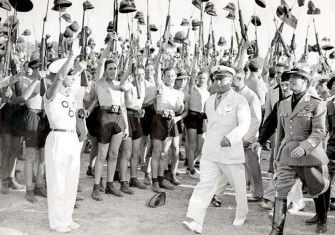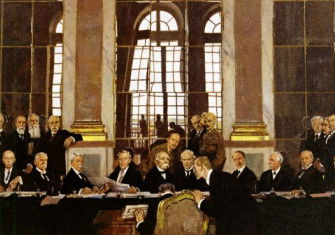Gabriele D’Annunzio’s Fiume Escapade
The poet’s conquest of the Adriatic city of Fiume in 1919 was flamboyant, comedic and never likely to last – but it ushered in a new era of showman politics across Europe.
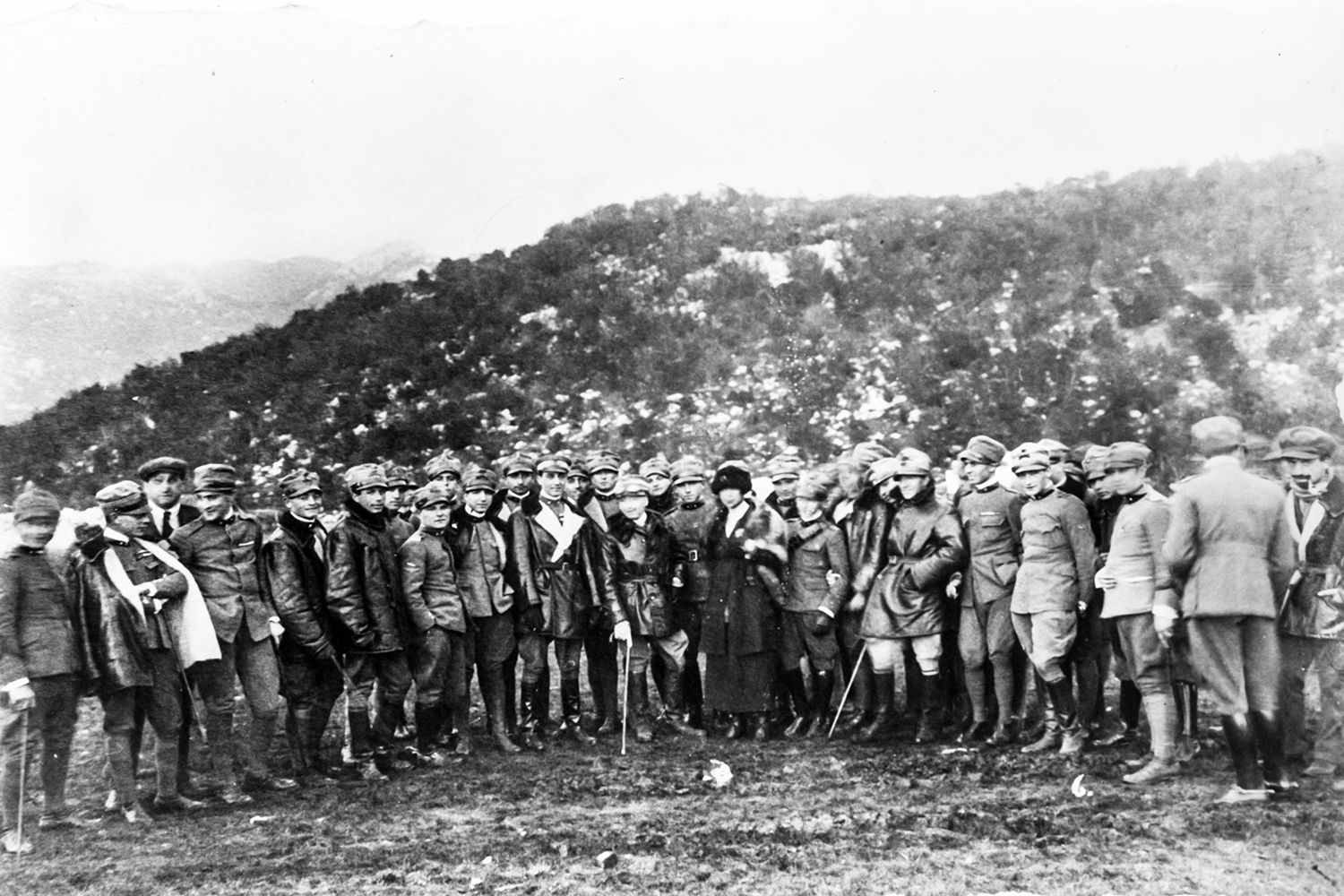
Gabriele D'Annunzio and supporters in Fiume, 1919.
On 12 September 1919, the rubber-faced poet-aviator Gabriele D’Annunzio, Italian nationalism’s propagandist-in-chief, swooped into the port of Fiume (now Rijeka) on the Adriatic and claimed it for Italy. He did so in opposition to the decisions of the Great Powers on the fate of the mixed Italian-Croatian city, and the Italian government in Rome.
So began an era of European showman politics, testing the limits of the peace settlements which were supposed to end the Great War – and ultimately hollowing them out entirely. The war, it turned out, had not really ended in 1918 at all. It was merely transmuted into a new set of civil wars and revolutions, conflicts and convulsions, of which the conquest of Fiume was the most theatrical. The crucible of war became the crucible of an imperfect peace, in which culture, politics and ideology were all thrown together, old verities trashed and new theories born. And it kept boiling for several years more, reshaping the continent and sowing fresh anger, new fears and new ideologies deep into Europe’s very fabric.
It is remarkable that the process of de-legitimisation of the Versailles peace settlement received one of its earliest impulses – and most flamboyant – not in one of the countries defeated in the war – Germany, Austria or the Ottoman Empire – but in one of the supposed victors. D’Annunzio himself had never really bought into the idea of peace. He was unconvinced by the worship of Woodrow Wilson the peacemaker which swelled across Europe after the armistice. (Mussolini, in contrast, wrote a flattering article declaring Italy the most Wilsonian nation of all). Personally, he liked war, D’Annunzio told an associate. He warned of the risk of Italy’s military victory being mutilated by the politicians. ‘Not only has our war not ended’, he wrote in early 1919, ‘it has only now reached its climax.’ Nationalists were incensed by the outcome at Versailles. Italian blood had been spilled without the country receiving its just rewards. One of these was supposed to be the coast of Dalmatia (now mostly Croatia).
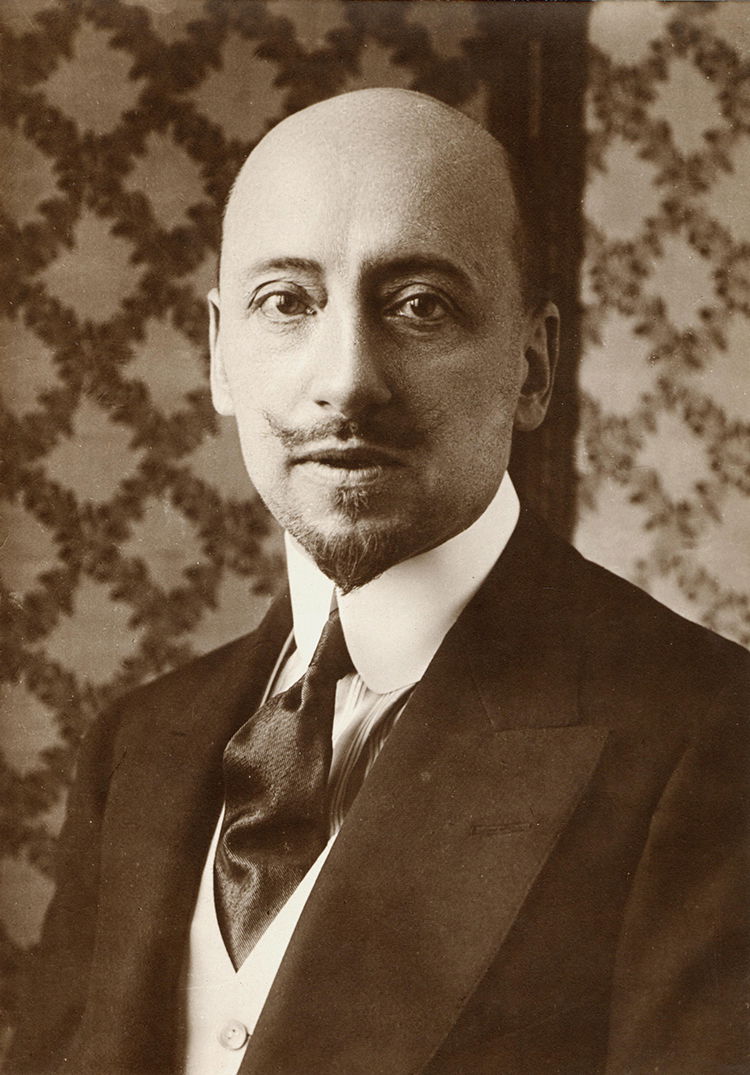
D’Annunzio freely admitted a comic element to the rigmarole in Fiume on 12 September 1919. He claimed to have only made the final decision to take the city from his sick-bed, and only then because others wished him to. He faced no serious military opposition. An Italian general loyal to Rome half-heartedly ordered D’Annunzio to stop on the road into town. The poet theatrically offered up his medal-covered chest to the general and dared him to shoot him on the spot. Nationalist papers reported the general to have been entirely won over by this act of bravery, quoting his enthusiastic response: ‘Great Poet, I hope that your dream will be fulfilled, and that I may shout with you “Viva Fiume Italiana!”’
Thus delayed for a short while, D’Annunzio proceeded towards Fiume in a Fiat Tipo 4 at the head of a column of Italian army trucks stolen from a nearby depot. Black-shirted Arditi soldiers, renowned for their heroism and their style – Ernest Hemingway was a great fan – were among the poet’s followers that morning. So too a number of schoolboys excited by the drama of D’Annunzio’s act, brought up on stories of an earlier daring propaganda flight over the enemy city of Vienna in 1918, in which the poet dropped thousands of pamphlets (some hand-written) warning the Austrians to surrender now to the unstoppable force of the Italian spirit – and threatening to come back next time with bombs.
By afternoon, D’Annunzio was fully in charge. The British and the French did not know what to do, not wanting to get stuck in the middle of an intra-Italian squabble. The poet launched Fiume into the global limelight, with himself at its centre. The Italian navy imposed a leaky blockade. When parties were held in Fiume – which happened a lot – boats would bring in army officers to enjoy the uninhibited carousing for which the city now became known. Money flowed in from supporters in the rest of Italy, along with fresh nationalist recruits hoping to catch a bit of the excitement.
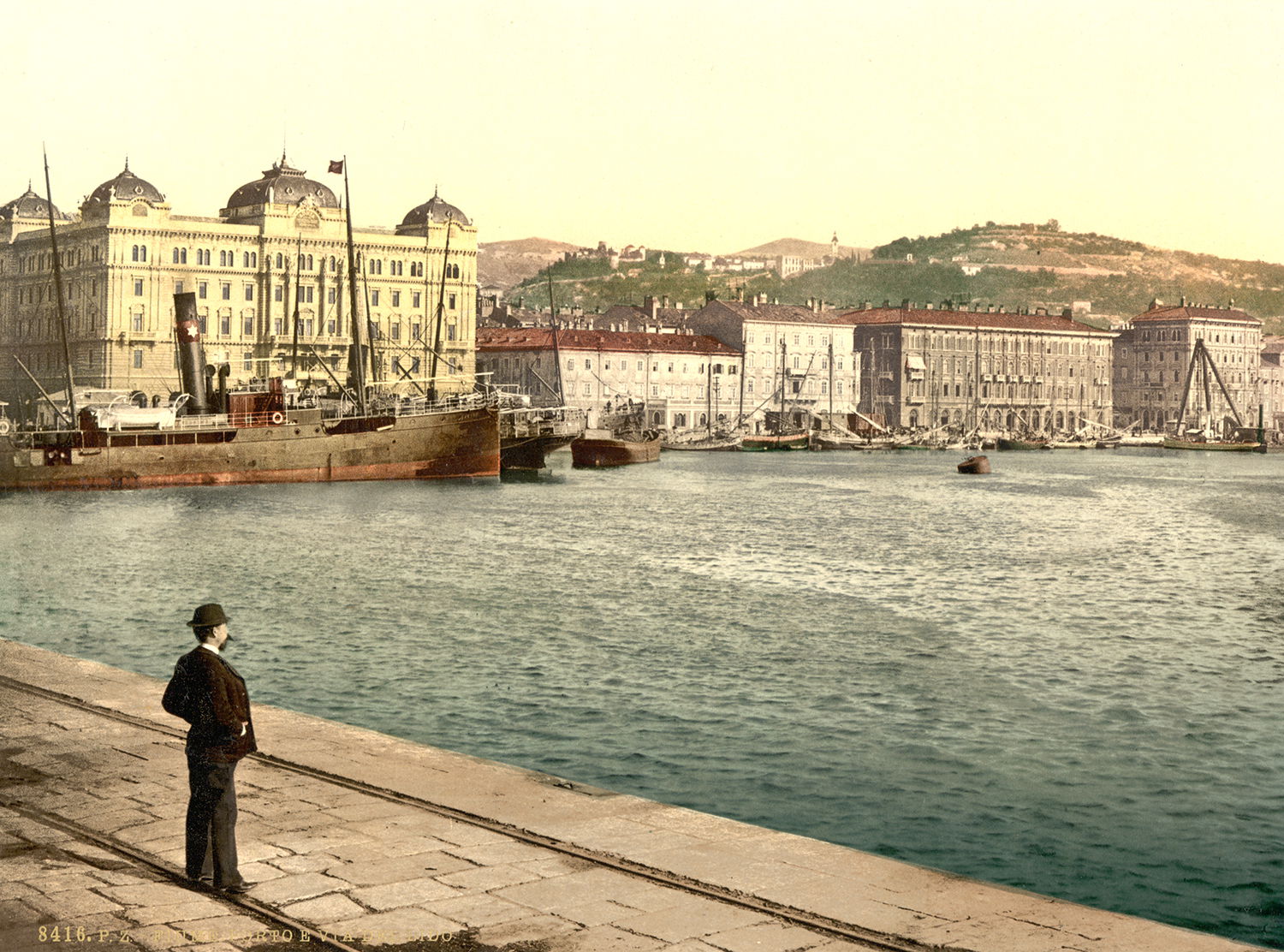
Magnificent processions followed D’Annunzio’s conquest of Fiume. And long, rambling speeches from various balconies – beyond parody, beyond art, beyond meaning anyone could discern, but delivered with fantastic passion and style. Filippo Marinetti, the moustachioed Italian poet who before the war had advocated a new cult of speed, symbolised by aeroplanes and car crashes, paid a visit. He declared the city ‘truly Futurist’. Various artistic and political oddballs with causes that were not properly listened to elsewhere descended on the city. Irish republicans tried to buy weapons there to fight against the British. Flemish nationalists made a bee-line for the Adriatic. D’Annunzio adopted the motto ‘Me ne frego’ – essentially, ‘I don’t give a damn.’
The nationalist newspaper editor Benito Mussolini, who liked to think of himself as D’Annunzio’s equal, but who D’Annunzio viewed as little more than a useful PR man, wrote articles supporting the Fiume adventure from the safety of Milan. He called it the ‘first act of revolt’ against Versailles. D’Annunzio’s response to Mussolini’s articles was to ask why the Italian premier had not been ousted in Rome. ‘I am astonished at you and the Italian people’, the poet wrote: ‘Any other country – even Lapland – would have overthrown that man’. He advised Mussolini to ‘prick the belly which weighs you down’ to let some of the hot air out. Mussolini published the letter in his newspaper with the unflattering bits taken out.
Undoubtedly Fiume might have blown up without D’Annunzio. Diplomatic reports in the archives in Washington show tension building long before September 1919. America’s man on the ground noted the appearance of posters proclaiming ‘Italy or Death’ over the spring and summer (and Italian soldiers putting some of them up). He was jostled in the street as rioting against the prospect of Fiume being anything other than an integral part of Italy (certainly not adjoined in any way to the new Yugoslavia) took hold, with Italian police failing to intervene. He saw the window of a restaurant smashed when a rumour spread through the city that a French officer was dining there (the French were considered to have sold out Italy in Paris). Another time, a French soldier was reported killed. A local Croatian club was sacked by rioters, and Croatian teens allegedly shot by police for no reason other than failing to show sufficient respect. All this, months before D’Annunzio swept in.
But it took the poet himself to crystallise all this into a national and ultimately an international crisis. His extravagant personality was perfectly suited to his being the front man for such foreign policy adventures (even if it was totally unsuited to dealing with their consequences). D’Annunzio was eventually turfed out of Fiume over Christmas 1920, when Italians had better things to do than worry about a town on the other side of the Adriatic and the newspapers were in holiday mode. The Fiume adventure and Gabriele D’Annunzio were inseparable in the public mind. Its end marked him down as a chancer (though some people, including Hemingway, who used to give the poet’s books away to his female friends, still thought he might have a political future years later).
Mussolini, always more of a schemer than the poet, learned from D’Annunzio’s failure. The rise of Italian fascism owed much to D’Annunzian flair. But it was better organised. The squadristi paramilitary gangs which roamed the Italian countryside in the years after the war – with strange and piratical rituals, often involving local alcohol – were channelled into political action: hired out as anti-socialist agitators, or as strike breakers, and then as the shock troops of the fascist movement. When Mussolini’s own Fiume moment came in 1922 with his March on Rome it was still a gamble. But the political ground was much better prepared. The leader kept himself back in Milan in case it went wrong. He eventually turned up in Rome, after his political objectives had succeeded, on a sleeper train. (The train stopped wherever there was any demand at all for a speech.) D’Annunzio enjoyed riding the waves of public emotion which he whipped up through his actions. Mussolini knew how to put such things to use for his own ends.
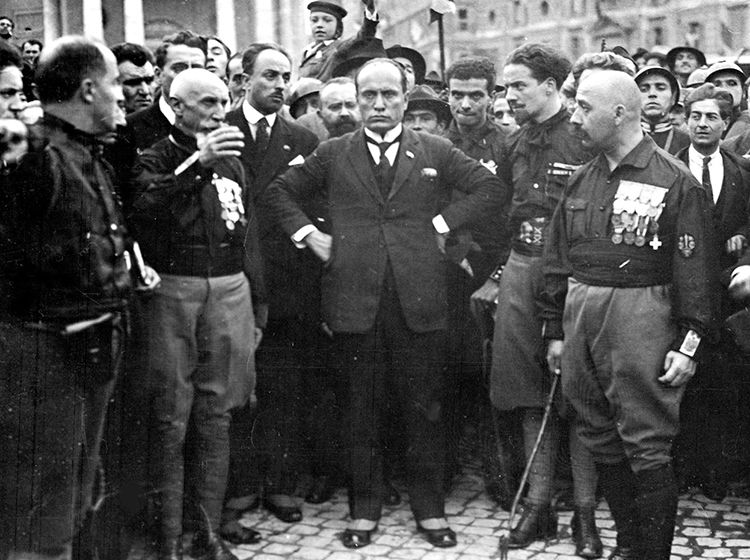
Given the extraordinary character of its leading light, the drugs and sex and booze involved in the Fiume adventure, and its mixed result, the episode is sometimes taken as a somewhat comic footnote to the chaotic history of Europe in the crucible years from 1917 to 1923. But it deserves to be taken more seriously as a harbinger of things to come, as an emblem of wider European processes, when the state ceased to exercise a monopoly on violence – this was true in Ireland, Germany and Turkey as well as Italy – and when a cultural stance could fuse with a political one to create fascism (irrespective of whether D’Annunzio himself could be reasonably called a fascist).
Where D’Annunzio led, others followed. On the same day the Italian poet entered Fiume, Adolf Hitler attended his first meeting of the German Workers’ Party in Munich (to take notes for his boss in the army’s propaganda department). In Turkey, Mustafa Kemal began his shadow campaign to ensure that the defeat of the Ottoman Empire in the war would not be the last word for the Turkish nation. The idea that a coup d’état might conceivably be launched with a coup de théâtre in a secondary city, with a dramatic public affairs triumph, proved ill-founded in the case of Fiume. But the Fiume escapade did enter the playbook of other political leaders across the continent seeking to blow up the peace settlements of the Great War.
In a time when European governments struggled to demonstrate their legitimacy to their people, Fiume served as an example of what could be achieved by a bravura act, by performative politics. The fact that D’Annunzio did not succeed just meant that others had to do a better job.
Charles Emmerson is the author of Crucible: The Long End of the Great War and the Birth of a New World, 1917-1924 (Bodley Head, 2019). @charlesemmerson



